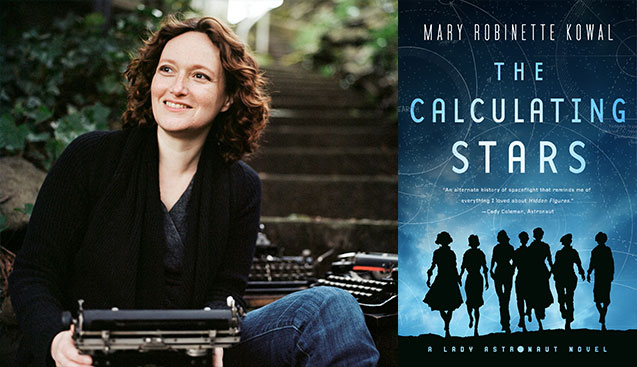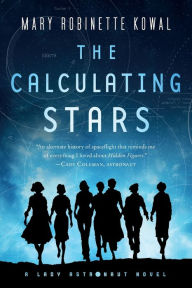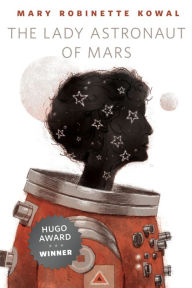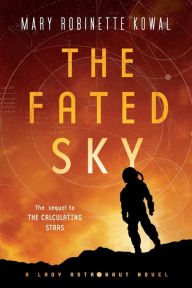The Lady Astronaut of Mars Returns: Mary Robinette Kowal on Crewed Spaceflight, Zero-G Fruit Roll-Ups, and The Calculating Stars
 Mary Robinette Kowal is one of genre fiction’s most versatile working authors. A writer of novellas, novelettes, novels, and short stories that smear the lines between sci-fi and fantasy, she’s also a prolific voice actor and puppeteer, and played a vital role in shaping the look of Shimmer, one of the central pillars of the modern renaissance in short genre fiction. Her work is always intensely perceptive and personal.
Mary Robinette Kowal is one of genre fiction’s most versatile working authors. A writer of novellas, novelettes, novels, and short stories that smear the lines between sci-fi and fantasy, she’s also a prolific voice actor and puppeteer, and played a vital role in shaping the look of Shimmer, one of the central pillars of the modern renaissance in short genre fiction. Her work is always intensely perceptive and personal.
The Calculating Stars (Lady Astronaut Series #1) (Hugo Award Winner)
The Calculating Stars (Lady Astronaut Series #1) (Hugo Award Winner)
In Stock Online
Paperback
$16.99
$18.99
And, with The Calculating Stars and The Fated Sky, a new duology set in the universe of her Hugo award-winning novella The Lady Astronaut of Mars, she’s created something truly extraordinary; a alternate history story about what happens after the world (almost) ends, and the opportunities that near apocalypse opens up. I talked to her about the novels, the life of Elma York, the challenges of modern spaceflight and planning a good asteroid strike.
And, with The Calculating Stars and The Fated Sky, a new duology set in the universe of her Hugo award-winning novella The Lady Astronaut of Mars, she’s created something truly extraordinary; a alternate history story about what happens after the world (almost) ends, and the opportunities that near apocalypse opens up. I talked to her about the novels, the life of Elma York, the challenges of modern spaceflight and planning a good asteroid strike.
First, walk us through the history of Elma York, the titular “lady astronaut” you’ve now written about three times.
There’s her fictional history, and then there’s the history of my relationship with the character. I began writing Elma as an older woman in the novelette The Lady Astronaut of Mars. Much of what I knew about her was necessarily limited in scope. The older Elma is a composite of my grandmothers and my mother in personality, although none of them were pilots or mathematicians. They are all smart, driven Southern women who appear to fit the mold of being proper ladies, but forced the rules to bend around them. When I wrote that first novelette, I was helping take care of Grandma after a surgery when she was 105 (She lived to 109). Watching her frustration at the limits imposed on her by age was…informative. I kept thinking about how much strength she has and how rarely we see older women in stories. So I wrote one.
What led you back to her?
I wanted to know what would allow a woman in the 1950s to become one of the first people on Mars. She would have to be pretty extraordinary in order to make it in a male-dominated field in a male-dominated world. At the same time, being extraordinary comes with its own set of damage.
So Elma is the daughter of a general. She was a brilliant mathematician, and because she came from a family of privilege, was able to attend college at fourteen. Being the only girl, and a child at that, in engineering and math was hard on her. Being a military brat meant that she couldn’t admit how hard it was. The damage, at that point, became baked into the character.
Well, that and the fact that her backstory involves a rock landing on Washington D.C.
The Lady Astronaut of Mars: A Tor.Com Original
The Lady Astronaut of Mars: A Tor.Com Original
In Stock Online
eBook $1.99
Did you always plan these to be a duology, or was there something about the story as it developed that lent itself to this format?
In fact, I had planned for this to be a single book originally. I had structured it like three sequential novellas, to fit the voice and format of the original Lady Astronaut of Mars. I had written the first two and begun the third and it felt awful. I realized that I was having to skip over a lot of really important emotional beats in order to “save” them for the third novelette. After fighting with it for a while, I went to my editor and explained that I wanted to split it into two books. The first “novelette” is more or less intact as Part 1 of Calculating Stars and I expanded the second into Part 2. Then I greatly expanded the third novelette to be Fated Sky.
Did you always plan these to be a duology, or was there something about the story as it developed that lent itself to this format?
In fact, I had planned for this to be a single book originally. I had structured it like three sequential novellas, to fit the voice and format of the original Lady Astronaut of Mars. I had written the first two and begun the third and it felt awful. I realized that I was having to skip over a lot of really important emotional beats in order to “save” them for the third novelette. After fighting with it for a while, I went to my editor and explained that I wanted to split it into two books. The first “novelette” is more or less intact as Part 1 of Calculating Stars and I expanded the second into Part 2. Then I greatly expanded the third novelette to be Fated Sky.
Let’s talk extinction level events. Why an asteroid, and why the East coast?
For that, we have to talk about a short story called “We Interrupt This Broadcast,” the first story I wrote in what I jokingly call my “punchcard punk” universe. This story contains information that none of the other characters in the Lady Astronaut universe know or will ever know. And it is… that the Meteor was aimed [by a misguided scientist], and calculated to create a golden age of humanity. He goofed a little because he thought that a water strike would be less devastating, and in fact, those are much, much worse. With a water strike, you get steam in the air, which can trigger a runaway greenhouse effect.
Typically what happens when there’s a major disaster is that people band together. If you wipe out the seat of government in a natural disaster, there aren’t retaliatory measures. As a writer, what I needed for the Lady Astronaut universe was a reason we got off the planet in the 1950s. That means a global effort and it means adding a time bomb to the Earth’s lifespan. It also means reducing the level of bureaucracy so that people can get things done. There’s about a two-year period where President Brannan can basically do whatever he wants.
So the asteroid was literally two birds with one stone.
The Fated Sky (Lady Astronaut Series #2)
The Fated Sky (Lady Astronaut Series #2)
In Stock Online
Paperback
$15.99
$17.99
Both novels are set in very specific time periods. What led you to them? Were there specific events in our timeline of crewed spaceflight that you wanted to explore?
I loved Ray Bradbury novels when I was growing up, and still love his turn of phrase. But they are very male-centered books. I wanted to write hard SF in the same time period he was writing, when the possibilities were still wide open, and have it be women-centered.
Both novels are set in very specific time periods. What led you to them? Were there specific events in our timeline of crewed spaceflight that you wanted to explore?
I loved Ray Bradbury novels when I was growing up, and still love his turn of phrase. But they are very male-centered books. I wanted to write hard SF in the same time period he was writing, when the possibilities were still wide open, and have it be women-centered.
Now, there’s also the fact that my introduction to computers was in the days of punchcards. My dad worked for IBM and one of my very early memories is going to have lunch at work with him. The gerbil tubes between buildings seemed very futuristic and then we went into the computer room which had banks and banks of massive machines with giant magnetic tapes. And punchcards! Technically the first “program” I wrote was getting a computer to print my name. (Also, they were what I drew on.)
So for me, the wonder and majesty of computers are linked to that memory. The fact that my cellphone can out-compute that room? That’s dull. But think about what we did in the infancy of computers? We sent people to the moon. I wanted all of that with, well, lady astronauts.
You’ve shared a lot on social media about your research into spaceflight. What was one of your favorite things you found? Was there anything in your research that almost made it into the novels but didn’t make it?
My answer is the same for both, actually. So when they are on a spacewalk, astronauts have water, but no food. They used to have a fruit roll-up sort of thing in a sleeve in the suit and they would bend their head down to bite it, pulling it a little farther up the tube. The problem was that the little bit at the end would always come out of the sleeve. So then you have a random piece of slobbered on fruit roll-up floating around inside your suit. I desperately wanted to get that in the novels, but there wasn’t a spot for it.
The novels subvert the idea that astronauts of the era all had to be square-jawed male test pilots. Do you think that belief is still perpetuated today?
Absolutely. It’s something that the women astronauts have to combat all the time, still, at NASA. I mean, look, the 2017 class of twelve astronaut candidates has five women in it. Group 21, selected in 2013 has gender parity. Group 20, selected in 2009 has four women out of a class of twelve. That class of astronauts is just beginning to fly and it will be years before the later classes do. I could go on, but you get the point. It’s still a male-dominated field.
What makes it especially difficult for the women is that any complaint will be seen as a sign of weakness. For instance, Cady Coleman talked about the fact that NASA decided to eliminate the extra-small EVA suits and the extra-large ones, for budget reasons. They brought the extra-large ones back because there were men who wouldn’t fit in the large ones. The extra-small ones? Still gone.
So a woman at the bottom end of the size range has to work in a suit that is too big for her. If she complains… well, no one else has had problems with it, so it must be her. Maybe she shouldn’t do spacewalks. So no one complains.
What’s next for you? And is more on deck for Elma?
I’m writing short fiction and working on a novel that has nothing to do with space at all. It’s sort of a Hitchcockian suspense-thriller with dragons. Still the 1950s, sort of. As for Elma, I have stories I want to tell about other people in her universe, but she’s had a rough couple of years, so I think she gets a break. I mean, until that thing with the Venus probe happens. La!
The Calculating Stars is out now. The Fated Sky will be published on August 21.


